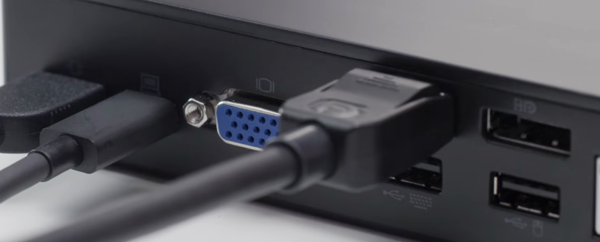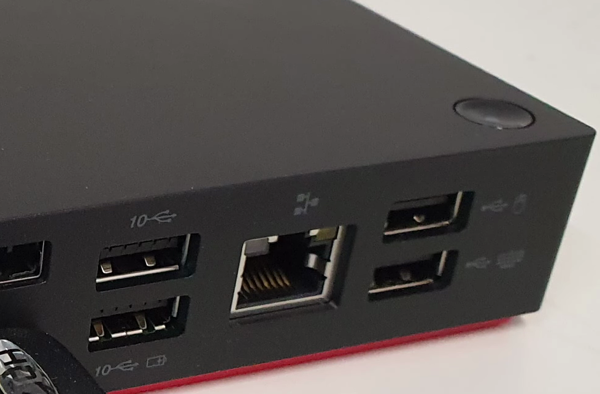Note: As an Amazon Associate I earn from qualifying purchases.
Review: Using the Lenovo ThinkPad USB-C Dock Gen 2 (2024)
Introduction
I recently upgraded my home office setup with the Lenovo ThinkPad USB-C Dock Gen 2. As a heavy user of multiple monitors and various peripherals, I needed a single solution to connect everything smoothly and efficiently. The dock got my interest due to its promise of seamless connectivity and power delivery.
Specifications
| Property | Value | Property | Value |
|---|---|---|---|
| Brand | AOM | Color | Black |
| Hardware Interface | Ethernet | Compatible Devices | Computers |
| Total USB Ports | 5 | Number of Ports | 2 |
| Item Weight | 11.46 Ounces | Total HDMI Ports | 1 |
| Wattage | 90 watts |
Photos
Click on photos to enlarge them:
Prices
Check prices of the Lenovo ThinkPad USB-C Dock Gen 2 on:
Overall Design and Build

The Lenovo ThinkPad USB-C Dock Gen 2 sports a sleek, non-intrusive black color scheme that easily blends with my workspace aesthetics. What stands out immediately in this dock is its strong range of connectivity options which quite literally serve as the central hub for my desktop setup. Here’s an early breakdown:
The detachable USB Type-C cable is a thoughtful design choice that adds to the dock’s flexibility.
I appreciate having a total of five USB ports, including three USB 3.1 Gen 2 Type-A and two USB 2.0 Type-A ports for a variety of peripherals.
Video output options are generous with two DisplayPort 1.4 and one HDMI 2.0 port, which allow me to easily handle my multi-monitor setup.
The inclusion of a Gigabit Ethernet port is a welcome feature for stable wired internet connection, especially during intensive tasks or video conferences.
Physically, the dock is compact and light at just 11.46 ounces, so it doesn’t clutter my desk. The build quality feels durable, and the ports have a satisfying, firm plug-in action without being too tight or too loose.
One minor frustration is the single USB 3.1 Gen 2 Type-C port; while it’s efficient, I can’t help but wish for a second one to avoid choosing between charging a phone or connecting a Type-C device without resorting to adapters. However, the three USB 3.1 Gen 2 Type-A ports generously compensate for this, providing both high-speed data transfer and substantial charging power output.
The ability to support resolutions up to 3840 x 2160 is exceptional for detail-oriented tasks, and its general compatibility with Windows systems makes it a plug-and-play solution for many users, myself included. The 3.5mm headphone/mic jack is a crucial touch for those needing direct audio connections without disturbing the desk setup too much.
One of the more personal touches I’ve noticed is the UltrSoft AOM MicroFiber Cloth included in the AOM Starter Bundle. It may seem small, but when investing in a long-term desk setup, maintaining dust-free and clean peripherals is a relief.
The dock’s design supports up to three external displays, making multitasking a breeze. The AOM brand’s attention to subtle details, like including a Quick HDMI Cable with Ethernet, equates to one less trip to the store or an additional online order.
However, not everything is perfect. The necessity to cable up correctly, depending on your system requirements, might require some initial research and could potentially mean purchasing additional cables if upgrading from a previous dock generation.
In all, the Lenovo ThinkPad USB-C Dock Gen 2 reflects a balance between form and functionality. While there are some minor drawbacks, primarily the lack of an additional Type-C port, the strengths in its expansive connectivity and overall build quality make it a reliable addition to my professional workspace.
Connectivity and Performance

In the realm of connectivity and enhancing workspace efficiency, the Lenovo ThinkPad USB-C Dock Gen 2 has been a considerable asset to my setup. My goal was simple: Expand my laptop’s connectivity for a multi-monitor setup while maintaining a clean and organized desk. Here’s my take on the dock’s performance:
Multiple Ports for Versatility: The variety of ports is impressive. Having one USB 3.1 Gen 2 Type-C port, three USB 3.1 Gen 2 Type-A ports, and two USB 2.0 ports means that all of my devices can stay connected. This is a significant upgrade from my previous setup, where I constantly had to swap cables.
Display Options: The capacity to connect up to three external displays is fantastic. Depending on your system’s DisplayPort capabilities, the resolution support varies. I’ve been able to run two 4K monitors at 30 Hz without any hiccups, which has significantly boosted my productivity.
Plug-and-Play: The simplicity of setup was really appreciated. It was practically plug-and-play with my Windows 10 system, and I got everything up and running with minimal effort.
Portable Design: Its compact form factor surprised me — easy to transport if needed — shining in temporary workspaces or when I’m on the go.
However, not all is perfect. If your system doesn’t support DisplayPort 1.4, for instance, you’ll be limited to lower refresh rates on high-resolution displays. Also, the single HDMI port and two DisplayPorts might require some to purchase additional cables if coming from a dock with a different configuration.
From a practical standpoint, the dock meets most of my needs. I can switch between workspaces effortlessly, which has proven invaluable in my daily grind. The performance is robust for everyday tasks — from web browsing and document editing to more demanding activities like video conferencing and multimedia tasks.
Here are some highlights, in list form, reflecting my experience:
Pros:
Expansive port selection
Supports high-resolution displays
Easy setup with Windows systems
Handy charging via USB Type-A port
Cons:
Limited refresh rate with DisplayPort 1.2 systems
Only one HDMI port could be restrictive
While this section doesn’t dive into its design or power delivery, it’s worth noting that these elements also play into the user experience – often in a more indirect way. And regarding longevity, while I’m relatively new to using this product, it’s something to watch over time considering the investment.
Overall, if you’re vested in a Lenovo ecosystem or simply in need of a reliable docking solution, the ThinkPad USB-C Dock Gen 2 has a lot to offer. It’s not without its slight drawbacks, but the benefits, particularly in terms of the available ports and display capabilities, have made a noticeable improvement to my workflow.
Power Delivery and Limitations

When it comes to docks, one of the critical factors for me is power delivery and, unfortunately, limitations often accompany the vast connectivity options they present. The ThinkPad USB-C Dock Gen 2’s 90W AC adapter is designed to power your laptop, but this dock may not always have enough juice to drive all installed peripherals while also charging your system. Below are some of my observations:
Power to the laptop: It charges my laptop without a hitch, keeping it topped off through extended use.
Peripheral power: While the dock can handle basic peripherals like a keyboard and mouse, power-hungry devices could push it to its limit.
Secondary Displays: Running dual monitors is seamless, yet when I attempted to add my hefty 27-inch display, the dock couldn’t handle both the display and a high power draw peripheral.
This isn’t surprising. Docks are, by necessity, a balancing act between form, function, and the limitations of current technology. While there’s a slight drawback here concerning power division, I’ve found that for everyday tasks such as web browsing, document editing, and video conferencing, the dock performs admirably. Plus, its ability to support three external displays enhances productivity – so long as you keep power limitations in mind.
There are a few important points to consider:
The dock’s USB 3.1 Gen 2 Type-A port offering 5V / 3A charging is beneficial for smartphones and other small devices.
If you’re working with higher power draw peripherals, you’ll need to plan accordingly or they may not function as expected when attached to the dock.
The detachable USB Type-C cable offers flexibility, but mind that frequent attachment and detachment can lead to wear and tear, which has been noticeable as I’ve gone through multiple cables over a year, similar to some of my colleagues.
Admittedly, the device is on the expensive side for its class, but features like the Gigabit Ethernet port and the headphone/mic jack do help to ensure it’s the central hub for my setup. The dock might not be perfect regarding its power delivery to peripherals. Still, considering the convenience of connecting multiple devices through one cable, the benefits outweigh the limitations for my usage.
Overall, the dock’s power capabilities do match its design intentions—to streamline connectivity with a focus on compatible devices. When you’ve got it all set up and working within its power parameters, it does make for a satisfying, clutter-free workspace.
Longevity and Value

When it comes to the Lenovo ThinkPad USB-C Dock Gen 2, my experience is different from what some reviews might suggest, especially regarding its longevity and value. As a tech enthusiast and a professional who relies on a well-oiled workstation, I’ve come to appreciate the intricate balance between the two.
Here’s a summary of my thoughts:
Pros:
Expansive connectivity with multiple ports
Reliable performance with three external display support
Quick and easy setup process
Cons:
The dock can be pricey compared to others in the market
Longevity of included cables may be a concern
This dock’s variety of ports has made my work-from-home experience seamless, offering ample USB ports and display outputs that keep all my peripherals connected. The ability to drive three monitors simultaneously is nothing short of a productivity boost. With such advanced capabilities, the dock does present a good value for those who need a comprehensive docking solution.
However, the concern about the longevity of the USB-C cables is valid from my point of view. I’ve found myself going through cables more frequently than expected, which is a drawback considering the overall cost. While the dock functions as it should, the additional expense and inconvenience of replacing cables do slightly tarnish the impression of value over time.
It’s worth noting that the docking station itself has held up well. Beyond the cable issue, I haven’t experienced any problems with the actual hardware, reinforcing the reputation for reliability that Lenovo products tend to have. This aligns with my expectations for a premium device, and despite its cost, it has largely delivered on its promises.
Moreover, the ease of setup and compatibility with Windows systems adds to the overall positive user experience. Although I haven’t had the dock for an extended period, it has so far met my daily professional demands without fail. However, I will keep an eye on how it fares in the months to come, hoping it will outlast its predecessor.
In summary, while the Lenovo ThinkPad USB-C Dock Gen 2 leans toward the higher end of the market in terms of price, its expansive connectivity options and reliable performance provide considerable value, particularly for power users with multiple displays. With cautious regard to accessory longevity, particularly the durability of cables, it has the potential to be a lasting investment in one’s personal or professional tech setup.




